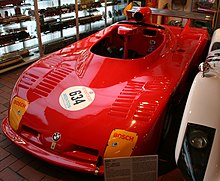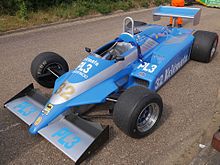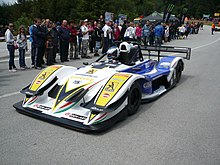
Edward McKayCheever Jr. is an American former racing driver who raced for almost 30 years in Formula One, sports cars, CART, and the Indy Racing League. Cheever participated in 143 Formula One World Championship races and started 132, more than any other American, driving for nine different teams from 1978 through 1989. In 1996, he formed his own IRL team, Team Cheever, and won the 1998 Indianapolis 500 as both owner and driver. The team later competed in sports cars.

The 1984 South African Grand Prix was a Formula One motor race held at Kyalami on 7 April 1984. It was race 2 of 16 in the 1984 Formula One World Championship. The 75-lap race was won by Niki Lauda, driving a McLaren-TAG, with teammate Alain Prost second and Derek Warwick third in a Renault.

The 1984 Italian Grand Prix was a Formula One motor race held at Monza on 9 September 1984. It was the fourteenth race of the 1984 Formula One World Championship.

The 1986 Italian Grand Prix was a Formula One motor race held at Monza on 7 September 1986. It was the thirteenth race of the 1986 Formula One World Championship.
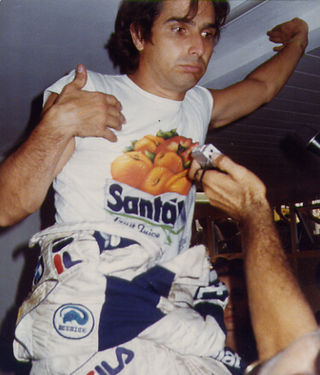
The 1987 FIA Formula One World Championship was the 41st season of FIA Formula One motor racing. It featured the 1987 Formula One World Championship for Drivers and the 1987 Formula One World Championship for Constructors, which were contested concurrently over a sixteen-race series that commenced on 12 April and ended on 15 November. The World Championship for Drivers was won by Nelson Piquet, and the World Championship for Constructors by Williams-Honda. The season also encompassed the Jim Clark Trophy and the Colin Chapman Trophy, which were respectively contested by drivers and constructors of Formula One cars powered by naturally aspirated engines.

The 1984 FIA Formula One World Championship was the 38th season of Fédération Internationale de l'Automobile (FIA) Formula One motor racing. Drivers and teams competed in sixteen Grands Prix for the World Drivers' and World Constructors' championship titles. The season ran from 5 March to 21 October.

The 1983 FIA Formula One World Championship was the 37th season of FIA Formula One motor racing. It featured the 1983 Formula One World Championship for Drivers and the 1983 Formula One World Championship for Constructors, which were contested concurrently over a fifteen-race series that commenced on 13 March and ended on 15 October. Nelson Piquet won the Drivers' Championship, his second Formula One title and the first to be won by a driver using a turbocharged engine, while Ferrari won the Constructors' Championship. It was also the last Drivers' Championship won by a Brabham driver.

Gabriele Tarquini is an Italian former racing driver. He participated in 78 Formula One Grands Prix, debuting on May 3, 1987. He scored a single championship point, and holds the record for the most failed attempts to qualify. He has subsequently raced successfully in Touring Cars, winning the BTCC in 1994, the ETCC in 2003 the WTCC in 2009 and the WTCR in 2018.

Piercarlo Ghinzani is a former racing driver from Italy. He currently manages his own racing team, Team Ghinzani, which was created in 1992 and is currently involved in several Formula Three championships.
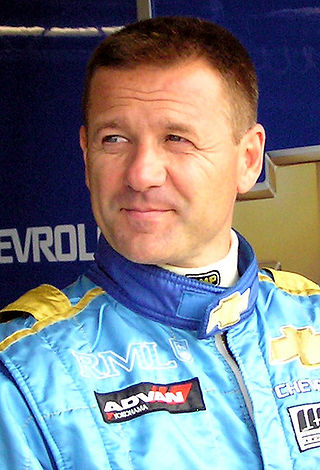
Nicola Larini is an Italian racing driver. He participated in 75 Formula One Grands Prix, debuting on 6 September 1987. He finished second in the tragic 1994 San Marino Grand Prix on a substitute outing for Ferrari, but only scored points once more in his career. He enjoyed greater success in touring car racing, primarily for Alfa Romeo.
Fondmetal S.p.A. is an Italian manufacturer of alloy wheels, founded in 1972 by Gabriele Rumi.

Carlo Chiti was an Italian racing car and engine designer best known for his long association with Alfa Romeo's racing department. He also worked for Ferrari and was involved in the design of the Ferrari 156 Sharknose car, with which Phil Hill won the 1961 championship.

The Alfa Romeo 184T is a Formula One car which was used by the Alfa Romeo team during the 1984 and 1985 Formula One seasons.
Italian motor manufacturer Alfa Romeo has participated multiple times in Formula One. The brand has competed in motor racing as both a constructor and engine supplier sporadically between 1950 and 1987, and later as a commercial partner since 2015. The company's works drivers won the first two World Drivers' Championships in the pre-war Alfetta: Nino Farina in 1950 and Juan Manuel Fangio in 1951. Following these successes, Alfa Romeo withdrew from Formula One.

The Brabham BT53 was a Formula One car designed by Gordon Murray for the Brabham team for the 1984 Formula One season and was a development of the BT52 which had carried the team's lead driver Nelson Piquet to the 1983 championship.

The Ligier JS29 was a Formula One car designed by Michel Têtu and Michel Beaujon for the Ligier team for use in the 1987 season. It was originally developed for use with an Alfa Romeo turbo power plant but prior to the start of the season, Ligier lost the use of the engine. The car had to be re-designed around a Megatron Straight 4 turbo engine. Redesignated the JS29B, it scored a single point during the season when driver René Arnoux finished 6th in the Belgian Grand Prix. Later in the season, the car was further refined to a JS29C specification.
Giorgio Stirano is an Italian racing car engineer, who worked for Forti and Osella in Formula One.
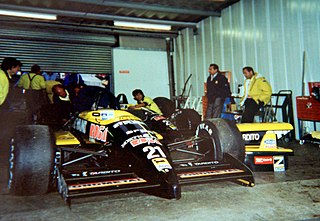
The Osella FA1L was a Formula One car designed by Antonio Tomaini and raced by Osella in the 1988 FIA Formula One World Championship. The car was the last Osella to be powered by a turbocharged engine, the 1.5-litre V8 named the Osella 890T. The car was driven by young Italian Nicola Larini who had made his F1 debut with Coloni in 1987.

Vincenzo "Enzo" Osella is an Italian former racing driver and team owner. He is the founder and chairman of Italian auto manufacturer Osella. The team competed in Formula One between 1980 and 1990.

Alfa Romeo has made three 8-cylinder Grand Prix racing engines designed for both Formula One and sports car racing; in both inline and V engine configurations. Their first was the supercharged 158/159, a straight-eight engine, with the 1.5 L engine configuration imposed by the FIA for forced induction engines, in 1950. After a 20-year gap, their second engine was the Tipo 33 engine, a 3-liter naturally-aspirated V8 engine, in 1970. Their third and final engine was the turbocharged 890T V8 engine in 1983, which was used by both Alfa Romeo until 1985, and Osella until 1988, until Alfa Romeo eventually pulled out of F1 that same year.




